Stories about...Next Generation School
 NGS Students Address Global Issues at 2020 Science and Engineering Fair
NGS Students Address Global Issues at 2020 Science and Engineering Fair
February 24, 2020
This year, for the Next Generation School (NGS) annual Science and Engineering Fair, the organizers made a slight change. Rather than students choosing to research any area as long as it was related to science or engineering, their projects were to address global issues. “We always want to keep things new and fresh for our children,” admits Head of School Chris Woller, “because we feel like that's also the world of science and engineering—new things are always popping up.”
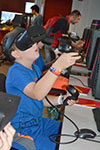 The Next Best Thing to Being There—STEAM Studio Youngsters Explore the Amazon with the Help of CITL
The Next Best Thing to Being There—STEAM Studio Youngsters Explore the Amazon with the Help of CITL
October 3, 2019
Here’s the scenario. On their way home from a gecko conference, their plane crashed in the Amazon, where they had to survive in the unfamiliar, somewhat hostile environment and to figure out how to return home using GPS technology. This scenario was part of a 6–8 week unit about the Amazon Rain Forest that third graders in Next Generation School’s STEAM Studio after-school program did this fall. Activities included studying geckos and building tents for shelter. Plus, to enhance their experience, they visited CITL’s (Center for Innovation in Teaching & Learning) Armory Innovation Spaces: Innovation Studio and TechHub. There, armed with VR goggles, they zoomed in on the Amazon using Google Earth, watched YouTube 360 videos to experience the rain forest, and even laser printed luggage tags. Immersed in such fun, creative, and high-tech activities to study the Amazon, what student couldn’t help but learn?
 Next Generation School’s New-Look Science and Engineering Fair Imparts the Same Old In-Depth Learning and Life-Long Skills
Next Generation School’s New-Look Science and Engineering Fair Imparts the Same Old In-Depth Learning and Life-Long Skills
Feburary 28, 2019
"Courage to Be Curious," Next Generation School’s Science and Engineering Fair on February 15th, had a bit different look than in previous years—you could see from one end of the gym to the other! What was missing was the roomful of large display boards on which students had explained their research in the past. In their place were laptops, which the older kids (4th grade and up) used to present their research on websites they’d created using Weeble, an online platform. Other than that, it was exactly the same. As in previous years, it was the highlight of the year for scores of excited kids who presented to community experts. Also as in previous years, there was no 1st place winner, but every child was a winner as they learned more about their chosen topic, embraced the scientific method or engineering process, and gained communication skills…including learning how to make a website!
 STEAM Studio AstroTech Unit Focuses on Telescopes Courtesy of Astronomy’s Wong
STEAM Studio AstroTech Unit Focuses on Telescopes Courtesy of Astronomy’s Wong
Feburary 22, 2019
When folks at STEAM Studio, Next Generation School's after-school program that emphasizes STEAM (Science, Technology, Engineering, and Math [STEM], plus Art) were planning a curriculum on Astro-Technology, they recalled that the father of one of their students was an astronomer. So it made perfect sense for Illinois Astronomy Professor, Tony Wong, to come and present to Kristi Hiatt’s Tera class (3rd–5th graders). During his visit, Wong didn’t get to share much about his research in molecular clouds, star formation, or the evolution of galaxies, but he did get to zero in on a tool he uses on a pretty regular basis: the telescope. And not only did the students learn about different kinds of telescopes and what they’re good for, they actually got to put together some Galileo telescopes and look through them to see what they could see.
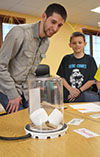 Van der Veen Team Teaches STEAM Studio Students Why Air Pressure Variations and Vacuums Warrant Wacky Weather
Van der Veen Team Teaches STEAM Studio Students Why Air Pressure Variations and Vacuums Warrant Wacky Weather
May 3, 2018
What happens to balloons in a bell jar when you remove the air pressure and create a vacuum? What happens to marshmallows? The liquid in a barometer? How do these relate to our weather?
A number of STEAM Studio third–fifth graders discovered the answers to these questions and more when two PhD students from Chemistry Professor Renske van der Veen’s lab visited on Wednesday, April 25th and Friday, April 27th. Because the goal of Next Generation Schools’ after-school program is to emphasize STEAM (Science, Technology, Engineering, and Math [STEM], along with Art), Tyler Haddock and Ryan Cornelius dropped by to present some scientific demos about air pressure—and how these different air pressure and vacuum effects are related to the weather—as part of Steam Studio’s Wacky Weather Week.
 NGS’ Science Social Café Exposes Girls to Women in Science—Broadens Narrow Notions About Careers in Science
NGS’ Science Social Café Exposes Girls to Women in Science—Broadens Narrow Notions About Careers in Science
March 30, 2018
Most Thursdays, eleven middle school girls from Next Generation School can be found at the school’s brand new Science Social Café Club, chatting over lunch with local women who are scientists. Besides learning about different potential careers, as the girls hear how these women got to where they are today, they’re also absorbing some pointers about discovering their own careers. Some key ideas they’ve learned are: 1) If you discover that you don’t really like what you originally planned to do, it’s ok to change your mind. 2) You can fashion a career out of some very disparate disciplines. 3) If there’s something you love and are passionate about, you just might be able to make a career out of it.
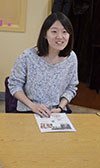 At NGS’ Science Social Café, MCBees Women Serve as Role Models, Exemplify Careers in Science
At NGS’ Science Social Café, MCBees Women Serve as Role Models, Exemplify Careers in Science
March 19, 2018
On Thursday March 9th, six MCB PhD students briefly put the work in their labs on hold to drop by the Science Social Café at Next Generation School’s STEAM Studio in Champaign. There, while a group of 11 middle school girls (and one boy) ate their lunches, they served as role models, explained a bit about how they ended up in science, shared what doing research as an MCB graduate student at Illinois is like, and described their career goals and other possible careers in their field. Plus, they were available to answer any of the younger students’ questions. The goal of the event? According to STEAM Studio Director Angela Nelson, it was to “break the boundary of ‘You could be a doctor, an engineer, or a lawyer,’” and open the youngsters up to the myriad possible careers, such as in science and research.
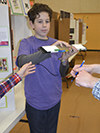 Students Hone Their Research Skills, Learn From Experts at NGS's 2018 Science & Engineering Fair
Students Hone Their Research Skills, Learn From Experts at NGS's 2018 Science & Engineering Fair
February 22, 2018
It was Friday, February 16th, 2018, the day of “Exploring Our Potential,” the Next Generation School’s (NGS) long-anticipated 2018 Science and Engineering Fair. The students finally got to stand in front of the poster they’d meticulously labored over and present the results of their research to a community expert. But while the experts had been instructed to give students not just positive feedback, but also things they could have done better or could improve upon, no doubt when mom and dad listened to their spiel during the evening session, they got only rave reviews.
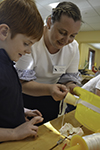 STEAM Studio Uses Science, Technology, and Art to Go “Virtually Spelunking” in Caves—Exploring Everything From Spiders to Bats to 3D Cave Painting to GPS
STEAM Studio Uses Science, Technology, and Art to Go “Virtually Spelunking” in Caves—Exploring Everything From Spiders to Bats to 3D Cave Painting to GPS
November 16, 2017
It all started with a unit on insects. Then, not to overlook them, spiders were given equal coverage. Then one thing led to another, until recently, STEAM Studio, Next Generation School’s after-school program which incorporates art into STEM (Science, Technology, Engineering, ART, and Mathematics), just finished doing an entire unit on caves which incorporated everything from identifying types of caves and how they’re formed, to sonar (how bats navigate through caves), to 3D cave painting, to exploring the world's caves through both GPS and virtual tours, and more.
 POETS’ Education Program Introduces Students of All Ages to Interdisciplinary Research in Electro-Thermal Systems
POETS’ Education Program Introduces Students of All Ages to Interdisciplinary Research in Electro-Thermal Systems
August 31, 2017
In addition to cutting-edge research in electro-thermal systems, the NSF-funded POETS (Power Optimization for Electro-Thermal Systems) Engineering Research Center has educational programs that expose students (as well as the teachers) to POETS’ research via educational activities, research, and courses that foster interdisciplinary collaboration and expose learners to the unique research that takes place in the Center.
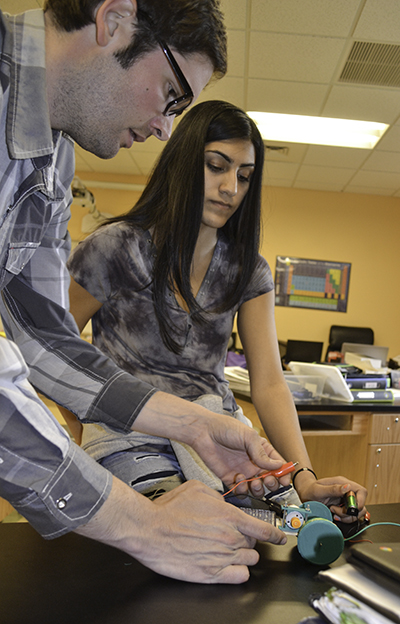 Local 8th Graders Build Solar Cars Courtesy of POETS' RET
Local 8th Graders Build Solar Cars Courtesy of POETS' RET
May 23, 2017
After working for weeks designing solar cars, teams of eighth graders at University Laboratory High School and Next Generation School were either exultant or chagrined as they tested their cars to see if they would move when exposed to bright light. The project was part of the POETS’ RET program, where a team of four local science teachers were tasked with creating a multi-week curriculum unit related to power, heat, and power density that was aligned with Illinois’ Next Generation Science Standards (NGSS).
FULL STORY
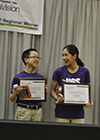 Local Youths' Renewable Energy Invention Propels Them to the Regionals in Toshiba’s ExploraVision Contest
Local Youths' Renewable Energy Invention Propels Them to the Regionals in Toshiba’s ExploraVision Contest
April 20, 2017
One doesn’t have to be an adult to be an inventor. Nor does one have to be an adult to be green. Dina Hashash and Lawrence Zhao, two local 7th graders at Next Generation School in Champaign are doing their part to promote renewable energy in order to help solve the energy crunch. As part of ExploraVision, Toshiba’s K–12 program designed to “engage the next generation in real-world problem solving, with a strong emphasis on STEM,” the two invented the BioKT. It's a watch-like device that harvests both kinetic and thermal energy from the body of its wearer. Their innovative design helped them reach the Regionals of the contest, an achievement celebrated by an awards ceremony at their school on April 13th.
FULL STORY
 NGS Middle Schoolers Build Bridges, Experience Engineering During EOH Design Contest
NGS Middle Schoolers Build Bridges, Experience Engineering During EOH Design Contest
March 23, 2017
It had all come down to this. It was crunch time—figuratively, and possibly literally, if their bridge built as part of the Engineering Open House (EOH) Middle School Design Contest collapsed while being tested. For weeks, three teams of eighth graders from Next Generation School (NGS) in Champaign had been designing bridges—building their prototypes, testing them, working out any kinks. Finally, Saturday, March 11th, the day of the contest, had arrived. With their fingers crossed, each team eagerly watched Illinois engineering students attach a bucket to their bridge then slowly fill it with sand. The idea was to see how much sand could be added before their bridge buckled. And whether they won an award or not, they’d learned a lot: about teamwork; about the engineering process; and what being a Civil Engineer might be like.
FULL STORY
 At the 2017 NGS Science & Engineering Fair, Every Student Is a Winner!
At the 2017 NGS Science & Engineering Fair, Every Student Is a Winner!
March 6, 2017
Friday, February 17th, 2017 wasn’t just any day at Next Generation School in Champaign; it was the day of the much-anticipated 2017 Science & Engineering Fair. And just as in previous years, it wasn’t a competition— no individual student or team won a ribbon or prize for having the best project. All the students were winners: they designed and completed a research project, learned the scientific or engineering method, and prepared a poster. Then, after working on their project for weeks, students finally got to present them to community experts, many from the University of Illinois, who provided not only positive comments about what students had done well, but ways they needed to improve, and even suggestions regarding further research they might do in the future.
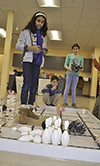 Wai-Tat Fu's Lab Partners with STEAM Studio To Make STEM, Spatial Reasoning Fun
Wai-Tat Fu's Lab Partners with STEAM Studio To Make STEM, Spatial Reasoning Fun
February 21, 2017
Hundreds of local adults and children converged on Altgeld Hall on Saturday, January 28th for Math Carnival: Gathering for Gardner. As they participated in the numerous puzzles, games, riddles, magic tricks, and other hands-on activities, they discovered that math is more than just figures and formulas.According to Melinda Lanius, a math Ph.D. student who, along with Assistant Professor Philipp Hieronymi, organized this year’s event, “Math is play!” So numerous volunteers from Illinois’ Department of Mathematics, Illinois Geometry Lab, and Association for Women in Mathematics spent the afternoon showing members of the community that play can indeed be math—and that it’s fun.
 Next Generation Preschool's Grazi Murad Imparts Love of Science, Animals to Students
Next Generation Preschool's Grazi Murad Imparts Love of Science, Animals to Students
January 30, 2017
Practically the first thing one sees upon entering Next Generation School’s Preschool is an intriguing, glass-enclosed structure—science teacher Grazi Murad’s classroom. When one ventures into the room, replete with exhibits, butterfly-filled cases, and animals in enclosures that simulate the different habitats the animals are from, her love of animals—and her students—is quite apparent. That her students love her and her hands-on style of teaching science is also readily apparent. The kids not only get to look at and hear about the eclectic range of animal friends in Murad’s menagerie, they get to meet them face to face—animals like Lizzy the Leopard Gecko, Gizmo the Bunny, Arnaldo the Chinese Water Dragon, and Bridget the Fire Corn Snake. They even get to touch them…if they’re brave enough.
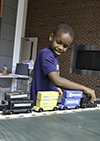 Illinois’ Chris Barkan and RailTEC Convey the Message: “Trains—They Run on 'STEAM' and They're Terrific!”
Illinois’ Chris Barkan and RailTEC Convey the Message: “Trains—They Run on 'STEAM' and They're Terrific!”
August 22, 2016
Chris Barkan, a Professor in Civil and Environmental Engineering, is passionate about trains. He knows about railroad technology and history—both in America and elsewhere in the world. Here at Illinois, he leads RailTEC, the Rail Transportation and Engineering Center, a world-class railroad research and educational program studying ways to make trains safer, faster, and more efficient— environmentally, economically, and energy-wise. Barkan is also devoted to educating the next generation of railway engineering professionals. And to make sure that railroads (and RailTEC) have a steady supply of bright young students, he, along with his colleague, Tyler Dick, and their rail engineering students teamed up with Angela Nelson at Next Generation School's STEAM Studio to organize and host STEAMvention 2016, where they used the fascinating and fun aspects of railroads to attract youngsters to a journey on the STEM pipeline.
STEAM Studio's STEAMcation Students Visit RailTEC...Learn All About Trains

August 17, 2016
Remember the excitement you felt as a youngster when you heard the shrill whistle of a train in the distance? Remember the magic of sitting at a railroad crossing, watching a train zoom by, waiting to shout, “The caboose!”?
Knowing that trains still engender excitement in youngsters, at RailTEC, Illinois’ Rail Transportation and Engineering Center, staff and students tap into youngsters' love of trains to teach them some STEM principles. And on August 3, 2016, a group of 24 local 3rd through 5th graders from STEAMcation, STEAM Studio’s 9-week summer program, visited RailTEC and experienced it firsthand. They spent the day learning about railroads; did a variety of fun, yet educational, hands-on activities related to railroads; plus had the chance to interact with some great role models—real, live engineers, who shared their passion for railroads and engineering with the youngsters.
FULL STORY
Illinois' MCBees Expose STEAM Studio's STEAMcation Students to Medieval Science
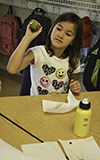
August 16, 2016
On July 25th, 24 local youngsters spent the morning doing some hands-on activities learning about science —in medieval times and today—as part of STEAMcation, the 9-week summer program of STEAM Studio, Next Generation School’s after-school and summer program. And taking the morning away from their labs to sharing their scientific expertise and passion about their field with the youngsters were a number of outreach-minded Ph.D. students who are members of the MCBees, a graduate student group from MCB (Molecular and Cellular Biology).
FULL STORY
STEAMcation Provides Summer STEAM ...With a Little Help from Illinois Friends

August 16, 2016
The 48 local youngsters who spent the summer at STEAMcation doing activities which incorporated art into a variety of STEM-related activities not only had a lot of fun. They learned some STEM principles too. And helping teach the youngsters about some of these topics were a number of outreach-minded University of Illinois folk, such as the MCBees, a graduate student group from MCB (Molecular and Cellular Biology), and RailTEC, the Rail Transportation and Engineering Center.
FULL STORY
NGS Students on the Ball Teaching BTW Kindergarteners About Polymers
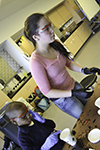
April 26, 2016
Garbed in rubber gloves and protective goggles, Next Generation School (NGS) eighth graders on a February 23rd field trip to Booker T Washington STEM Academy (BTW), shared with BTW kindergarteners the art of making bouncy balls. According to NGS Science Teacher Bryant Fritz, it was a win-win for both groups of students. His eighth graders experienced working with young children and how to take the principles they have learned down to a level younger students can understand. BTW youngsters were exposed to some lab principles, learned how to use scientific equipment, and, of course, ended up with a ball that they had made all by themselves (with a bit of help from their older mentors.) And they all had fun.
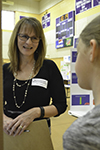 2016 NGS Science & Engineering Fair Fosters to Research/Presenting to Experts
2016 NGS Science & Engineering Fair Fosters to Research/Presenting to Experts
March 24, 2016
February 19th, 2016 was probably circled in red on the calendars of many Next Generation School students (and most likely their parents’ calendars, too). After weeks spent choosing a project, learning about their subject in depth, designing and conducting a research project, then making a poster, the day of the school’s Science and Engineering Fair had finally arrived. Projects completed, the students were excited to finally get to present their research—first, to a local expert, who gave them positive, and possibly negative, feedback—then later, to mom and dad during the evening session open to the public..
 Suarez & Josek Use Insects & Robots to Teach Bioinspiration at STEAM Studio
Suarez & Josek Use Insects & Robots to Teach Bioinspiration at STEAM Studio
October 14, 2015
Taking a short break from their entomology research, Illinois Professor Andy Suarez and Ph.D. student Tanya Josek visited Next Generation School’s STEAM Studio, an after-school program that incorporates art into its STEM activities (Science, Technology, Engineering, ART, and Math). There they taught the students about bioinspiration— how biology can inspire engineering. The two incorporated a variety of hands-on activities guaranteed to engage the youngsters, teaching them about a couple of their favorite subjects: insects and insect-inspired robots.
 2015 NGS Science & Engineering Fair Called the "Most Successful" Ever
2015 NGS Science & Engineering Fair Called the "Most Successful" Ever
February 18, 2015
Like a swarm of bees, a noticeable buzz of anticipation was in the air as students waited to present their science projects during Next Generation School's (NGS) Science and Engineering Fair. After weeks of prep both at home and in the classroom—it was finally the big day! The students would get to present their research to one of the local experts who had gathered for the event. The hope of the organizers was that these students would not only gain valuable feedback about their specific project, but that ultimately they would have gained a better understanding of the scientific process and possibly even a new passion to explore STEM fields when they grow up.
FULL STORY
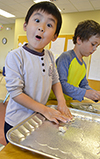 Next Gen's STEAM Studio: An After-School STEM Program With a Dab of Creativity
Next Gen's STEAM Studio: An After-School STEM Program With a Dab of Creativity
October 20, 2014
Most folks have now heard of STEM by now, right? It stands for Science, Technology, Engineering, and Math. Well, Next Generation School (Next Gen) has come up with a new after-school program—and its accompanying revision of the STEM acronym—STEAM. What does the "A"stand for? According to Angela Nelson, the program's director, while the main thrust of the program is still STEM, they've included an additional component: Art.
FULL STORY
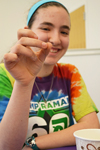 Memory Metal to Oobleck: NanoDays Makes Learning About Nanoscience Fun
Memory Metal to Oobleck: NanoDays Makes Learning About Nanoscience Fun
April 10, 2014
Last weekend, 22 6th–8th grade students from Next Generation School (NGS) participated in NanoDays, a program offering unique hands-on learning experiences about nanoscale science. The two-day event was held at the Champaign Public Library on Friday, April 4th, and the Orpheum Children's Science Museum on Saturday, April 5th. The role of NGS students was to demonstrate to NanoDays visitors the unique properties of nanoscale materials...
FULL STORY
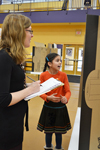 Next Generation School's Science and Engineering Fair: Every Student Is a Winner
Next Generation School's Science and Engineering Fair: Every Student Is a Winner
March 11, 2014
Compared to most science fairs, Next Generation School's Science and Engineering Fair is unique, in that no one student or team is designated the winner. After weeks researching and learning about a subject in depth, designing and conducting a research project, and finally making a poster presenting their results, during the February 21st fair, each student had the opportunity to present their research to a local expert for feedback—making all the students winners.
FULL STORY
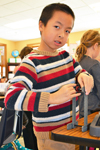 Next Generation School Pilots Project Lead the Way Elementary Curriculum
Next Generation School Pilots Project Lead the Way Elementary Curriculum
November 20, 2013
When the Big Bad Wolf shows up at the Three Little Pigs' houses to huff, puff, and blow them in, some Next Generation School kindergarteners concerned about the porkers' plight might now be able to do something about it. With the engineering principles learned through LAUNCH, Project Lead the Way's (PLTW) pilot program for elementary students, kindergarteners attempted to construct houses able to stand up to gale force winds (or a box fan, at least), thus ensuring the swine's safety.
FULL STORY
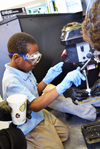 BTW Kindergarteners Have a Ball Learning About Polymers, Manufacturing
BTW Kindergarteners Have a Ball Learning About Polymers, Manufacturing
March 11, 2013
Amidst lots of glitter and armed with rubber gloves and goggles, Booker T. Washington STEM Academy (BTW) kindergarten students recently had the opportunity to make superballs—and were exposed to one type of manufacturing process while doing so. Assisting Nano-CEMM Education Coordinator Joe Muskin, who used his knowledge of nanotechnology and his teaching expertise to guide the youngsters through the process, were about six University pre-service teachers and a team of Next Generation middle school students who sacrificed their day off of school to help mentor the kindergarteners.
FULL STORY
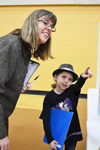 Next Generation School Fair: Tomorrow's Scientists & Engineers Meet Today's
Next Generation School Fair: Tomorrow's Scientists & Engineers Meet Today's
March 8, 2013
When Next Generation School needed some people knowledgeable about science and engineering to serve as judges for its 2013 Science and Engineering Fair, it didn't have far to look. Lucky enough to be in the same community as a world-class university, the school found plenty of folks willing to donate some time and energy to help shape some of tomorrow's scientists and engineers.
FULL STORY
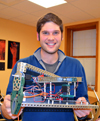 Local Teacher Uses Project Lead the Way to Prepare Next Generation of Engineers
Local Teacher Uses Project Lead the Way to Prepare Next Generation of Engineers
February 20, 2013
"Mr. Fritz, I'm going to be an engineer!"
This is what science teacher Bryant Fritz's middle school students are telling him when they greet him in the hallway these days. For a couple of years now, Next Generation School in Champaign has been incorporating Project Lead the Way STEM curriculum as part of its science curriculum for the 6th–8th grades, and it seems to be leaving an impression.
FULL STORY
 MechSE Gives Back to the Community
MechSE Gives Back to the Community
February 19, 2013
When Next Generation School science teacher Bryant Fritz needed a little help with a Project Lead the Way design and modeling unit involving computer-aided drafting (CAD) and printing 3D models, he knew just whom to call. He contacted the school's big brother to the north—the Mechanical Science and Engineering (MechSE) Department on the Engineering campus of the University of Illinois.
FULL STORY













.jpg)
















